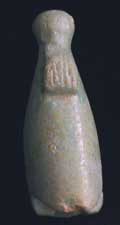New Kingdom Faience Hedjet Crown Amulet, 1600 BCE - 600 BCE
Faience
1.375
PF.2994
The ancient Egyptians conceived of their country as two separate lands, north and south, which became a unified whole at the beginning of the dynastic period. This popular conception is...
The ancient Egyptians conceived of their country as two separate lands, north and south, which became a unified whole at the beginning of the dynastic period. This popular conception is probably based on the actual Predynastic division of the land into separate kingdoms. The pharaoh was believed to have special religious and political significance as the unifying force, which held the state together. This aspect of his role is frequently represented by the titular identification of the pharaoh as "ruler of the two lands". The pharaoh is sometimes depicted being ritually anointed by Nekhbet and Buto the goddesses of upper and Lower Egypt, respectively. Equally important in emphasizing the pharaoh’s role in unification were the crowns that he wore. The tall, conical, white crown was symbolic of Upper Egypt and the flat red crown symbolized Lower Egypt. The king was shown with either or wearing the double crown, which is the red crown surmounted by the white crown. This elegant faience amulet represents the white crown of upper (southern) Egypt, which was protected by the vulture goddess Nekhbet and the god Set. According to tradition, it was the king of Upper Egypt who emerged victorious from the legendary battle between north and south. Perhaps this amulet commemorates that ancient victory and is reflective of the pre-eminence of Thebes.



